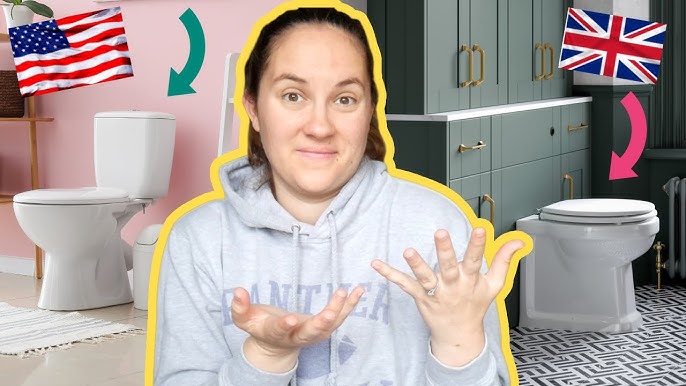When it comes to toilets, cultural and practical preferences play a significant role in their design and functionality. American toilets and European toilets differ in terms of style, functionality, water usage, and installation.
Difference Between American Toilet vs. European Toilet
Here’s a detailed comparison to help you understand their unique features.
1. Design and Style
American Toilets
- Standard Design: Most American toilets feature a two-piece design, where the tank and bowl are separate but connected. This is the most common and budget-friendly option.
- Size and Height: Toilets typically come in a standard height or comfort height (ADA-compliant, easier for elderly or disabled users).
- Seat Shape: Oval or elongated seats are common for comfort, though round seats are also widely used in smaller bathrooms.
- Tank System: Includes a visible tank mounted above the bowl.
European Toilets
- Modern and Compact Design: European toilets often feature a one-piece design or wall-mounted design, where the tank is concealed behind the wall for a sleek and minimalist look.
- Customizable Height: Wall-mounted toilets allow for adjustable height, making them ideal for customized installations.
- Seat Shape: Primarily oval for comfort but with slimmer designs for aesthetics.
- Tank System: Hidden within the wall, saving space and improving aesthetics.
Key Takeaway: European toilets emphasize modern design and space efficiency, while American toilets focus on traditional functionality and cost-effectiveness.
2. Flush Mechanism
American Toilets
- Gravity Flush: Uses water pressure and gravity to flush waste, which is simple and reliable.
- Dual Flush Options: Some modern American toilets offer dual-flush systems for water conservation.
- Water Tank Size: Generally larger tanks, with standard flush volumes of 1.6 gallons per flush (gpf).
European Toilets
- Dual Flush System: Almost all European toilets come with a dual flush mechanism, offering separate buttons for liquid (low-water flush) and solid waste (high-water flush). This saves water and is eco-friendly.
- Pressure-Assisted Flush: Some models use pressurized water for a stronger and more efficient flush.
- Flush Plate: Wall-mounted toilets feature flush plates instead of traditional levers, adding to their sleek look.
Key Takeaway: European toilets lead in water-saving technology with their dual-flush systems, while American toilets stick to gravity-based reliability but are catching up with dual-flush options.
3. Water Usage
American Toilets
- Standard Usage: Older models use up to 3.5 gallons per flush, but modern toilets are regulated to 1.6 gpf or less due to water-saving laws.
- Efficiency: WaterSense-labeled toilets in the U.S. use as little as 1.28 gpf.
European Toilets
- Low Usage: European toilets, especially dual-flush models, use significantly less water:
- Liquid Waste: Around 0.8 gallons per flush.
- Solid Waste: Around 1.6 gallons per flush.
- Eco-Friendly Focus: Designed to meet strict European water conservation standards.
Key Takeaway: European toilets are more water-efficient overall, though modern American toilets are also improving in this area.
4. Installation and Maintenance
American Toilets
- Easier Installation: Designed for floor-mounted setups, making installation simpler and more affordable.
- Accessible Repairs: The exposed tank and parts are easy to access for repairs and replacements.
- Heavier Design: Two-piece toilets are bulkier and require more space.
European Toilets
- Wall-Mounted Design: Requires professional installation due to hidden tanks and plumbing.
- Space-Saving: Ideal for smaller bathrooms due to compact and concealed components.
- Complex Repairs: Maintenance may require opening the wall, depending on the design.
Key Takeaway: American toilets are easier to install and maintain, while European toilets require more initial effort but save space and offer a modern look.
5. Cost
American Toilets
- Affordable Range: Prices for standard two-piece toilets start around $100-$300. High-efficiency or designer models can go up to $1,000.
- Lower Installation Costs: Simple installation processes keep costs down.
European Toilets
- Higher Initial Cost: Wall-mounted or one-piece toilets typically start around $300-$800, with luxury models exceeding $1,500.
- Installation Costs: Professional installation of wall-mounted designs can add significantly to the total cost.
Key Takeaway: American toilets are more budget-friendly, while European toilets are pricier due to their design and installation requirements.
6. Comfort and Hygiene
American Toilets
- Standard Comfort: Comfort height options make it easier for elderly or disabled individuals.
- Basic Hygiene: Standard models do not include additional hygiene features but can be upgraded with bidet attachments.
European Toilets
- Customizable Comfort: Adjustable height and compact designs cater to individual preferences.
- Advanced Hygiene: Many models come with built-in bidet features or are compatible with bidet seats, promoting better hygiene.
Key Takeaway: European toilets excel in hygiene and customization, while American toilets offer comfort with standard designs and upgradeable features.
Which Is Right for You?
Your choice between an American toilet and a European toilet depends on your priorities:
- Choose an American Toilet If:
- You want a cost-effective and easy-to-install option.
- You prefer traditional designs and accessible repairs.
- Your bathroom has plenty of space.
- Choose a European Toilet If:
- You value sleek, modern aesthetics and space-saving designs.
- Water efficiency and eco-friendliness are a priority.
- You’re willing to invest in professional installation for a high-end look.
Final Thoughts
Both American and European toilets have their advantages and are designed to meet different needs. If you’re looking for simplicity and affordability, an American toilet is a great choice. If you prioritize modern design, water efficiency, and advanced features, a European toilet offers superior functionality. Evaluate your bathroom layout, budget, and personal preferences to make the best decision for your home.



